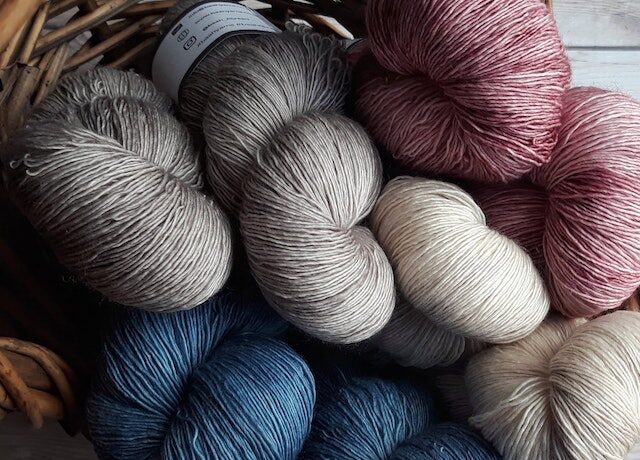Fans of yarn, take note! Have you ever been faced with a wall of vibrant yarn skeins and been unable to decide which one to use for your upcoming knitting or crochet project? You need not worry, though, as our comprehensive guide on selecting the best sort of yarn has you covered. This article will teach you all you need to know about choosing the ideal yarn for your next creation, regardless of whether you’re an experienced crafter or are just getting started. Now that you’re settled, grab some hooks or needles, and get ready to explore the fascinating world of fibre arts!
various types of yarn
Knowing which yarn is best for your project can be challenging given the wide variety available. This article will assist you in picking the best kind of yarn for your upcoming knitting or crochet project.
Acrylic yarn is created from synthetic fibres and is frequently less expensive than other types of yarn. It is available in a variety of colours and requires little maintenance. It may not keep its form as well as other fibres and may be less durable than other types of yarn.
Cotton yarn: Because it is absorbent and produced from natural fibres, cotton yarn is ideal for summer clothing. It could cost more than acrylic yarn and call for particular cleaning instructions.
Wool yarn is a warm form of yarn derived from animal fibres that is perfect for winter clothing. It may cost more than other types of yarn and need particular cleaning instructions.
Natural fibres are used to make linen yarn, which has a rustic appearance. It may cost more than other types of yarn and need particular cleaning instructions.click here to find out more about yarn types. click here to find out more on Yarn types

Plastic yarn
A form of synthetic yarn created from polymers is called acrylic yarn. It is frequently used in clothing and other products that need to be dry-cleaned or machine-washed. Acrylic yarn comes in a range of hues, finishes, and weights.
Acrylic yarn may be less irritating to certain people’s skin than other synthetic fibres. In comparison to wool or cotton, it is also less prone to pill (form little balls of fibre on the surface of the fabric).
For those with delicate skin or who are allergic to wool, acrylic yarn might be an excellent option. It is also a wise decision for projects that will be dry-cleaned or machine-washed.
A mohair yarn
Mohair yarn is the ideal option for your upcoming knitting or crochet project if you’re searching for a yarn that is sturdy, soft, and has a lovely lustre. The angora goat’s hair is used to manufacture mohair yarn, which has several advantages that make it perfect for everything from scarves to sweaters. When you start looking for yarn for your upcoming project, consider the following information about mohair.
Gains from Mohair Yarn
Mohair yarn is so well-liked by knitters and crocheters for a variety of factors. Only a few advantages that mohair yarn has are as follows:
– Softness: Because mohair yarn is so delicate to the touch, it is perfect for scarves and sweaters that will be worn close to the skin.
– Strength: Mohair yarn is actually fairly sturdy despite its softness. It can withstand a lot of wear and tear since it is not prone to stretching or ripping.
– Beauty: Mohair yarn has a lovely sheen due to its inherent gloss. This makes it ideal for finished products that you want to display, such shawls and wraps.
Problems with Mohair Yarn
Before you begin using mohair yarn, there are a few things to bear in mind. These are some possible negative effects of using this
alpaca fibre
Alpaca yarn is a rich, soft, and distinctive yarn that is perfect for your upcoming knitting or crochet project. The camelid family, which also contains llamas and vicunas, includes alpacas. They were domesticated more than 6,000 years ago and are indigenous to the highlands of South America.
There are two types of alpacas: huacaya and suri. The rich, fluffy fleece of huacaya alpacas is perfect for spinning into yarn. Long, silky fibres from Suri alpacas are frequently used to create opulent textiles. Both alpaca fibre kinds are silky and hypoallergenic while being incredibly robust and long-lasting.
It’s critical to consider both the weight (or thickness) and fibre content of an alpaca yarn when selecting one for your project. Alpaca yarns are available in a range of weights, including lace and chunky. If huacaya or suri alpacas were utilised to produce the yarn will also affect the fibre content.
There is thus bound to be an alpaca yarn that is ideal for your next project, whether you’re searching for a comfortable jumper knit with chunky-weight alpaca yarn or a delicate shawl crocheted with lace-weight yarn.
Woven yarn
If you’re searching for a warm, sturdy, and adaptable yarn for your next knitting or crochet project, wool yarn is a terrific alternative. Wool yarn may be found in a wide range of hues, textures, and weights and is produced from the hair of sheep and other animals.
Wool yarn is perfect for making blankets and other home décor items, as well as clothing like sweaters and caps. It’s a wonderful option for felting tasks as well. Wool yarn comes in both natural and coloured variations. Check the label of the wool yarn you choose to determine if it can be machine washed; some wool yarns need to be hand washed or dry cleaned.

How to Choose the Best Yarn Type for Your Project
There is no one size fits all when it comes to yarn. Your decision of the yarn for your project will be influenced by a variety of elements, including the project itself, your personal tastes, and your financial situation.
We’ve put up a thorough guide on choosing the proper sort of yarn to assist you in making the best choice for your upcoming knitting or crochet project. We’ll go over everything, including the many kinds of yarn that are available and how to pick the ideal yarn for your particular project.
We’ve put up the definitive guide on choosing the proper kind of yarn for your next knitting or crochet project, so read on if you’re a novice looking for some pointers or an experienced crafter needing a refresher.





